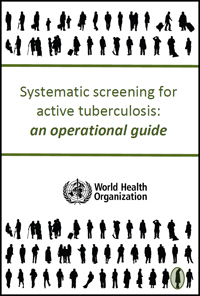
Missed and delayed diagnosis of tuberculosis (TB) can result in poor health outcomes for the affected individuals, catastrophic costs for their families, and continued transmission of TB to others in their communities.
Systematic screening for active TB among those at the highest risk can complement other efforts to improve early detection and treatment of TB. Building on the previously published “Principles and recommendations on systematic screening for active tuberculosis”, WHO has issued an operational guide that provides practical advice on how to develop a national or local TB screening strategy by:
- assessing the situation;
- defining the objectives of screening;
- prioritizing risk groups for screening;
- choosing screening tools, algorithms and approaches;
- planning and budgeting for, and implementing the strategy;
- monitoring and evaluating the strategy.
To further aid the process of prioritizing high-risk groups for screening and chose an appropriate screening and diagnostic algorithm, an eTool- ScreenTB has been developed, which helps estimate screening yield and cost of screening.
"With this guide and eTool, we aim to help countries make swift and effective choices to reach and serve more people with TB", said Dr Mario Raviglione, Director of the WHO Global TB Programme.
